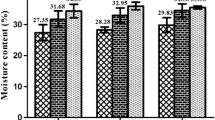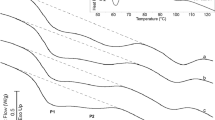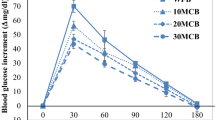Abstract
Resistant starch (RS) is defined as the sum of starch and products of starch degradation not absorbed in the small intestine of healthy individuals. RS appears to confer considerable health benefits. Processing conditions and ingredients may influence the formation of RS in foodstuffs. The aim of the present study was to investigate some of the factors that might influence RS formation in wheat bread, namely (1) formulation; (2) loaf size; (3) baking conditions; and (4) storage conditions. Seven bread formulations were prepared: reference recipe (control) and six experimental formulations. The effect of the loaf size and the baking conditions was also tested. Finally, the effect of storage was tested by keeping control breads under different storage conditions (temperature/time). Moisture and resistant starch contents were evaluated in all breads. A higher level of moisture in the dough and a larger loaf size enhanced the RS content. An extended baking process also favored significantly the formation of RS. Storing the bread at room temperature for 3 days was shown to further increase the RS content. It is possible to increase the RS content of bread by modifying the ingredients ratio and processing conditions.
Similar content being viewed by others
Notes
Association of Official Analytical Chemists.
American Association of Cereal Chemists.
References
Belitz H-D, Grosh W, Schieberle P (2009) Food chemistry, 4th revised and extended. Springer, Berlim
Englyst HN, Cummings JH (1985) Digestion of the polysaccharides of some cereal foods in the human small-intestine. Am J Clin Nutr 42(5):778–787
Asp NG, Bjorck I, Holm J, Nyman M, Siljestrom M (1987) Enzyme resistant starch fractions and dietary fiber. Scand J Gastroentero 22:29–32
Englyst HN, Kingman SM, Hudson GJ, Cummings JH (1996) Measurement of resistant starch in vitro and in vivo. Br J Nutr 75(5):749–755
Higgins JA, Brown IL (2013) Resistant starch: a promising dietary agent for the prevention/treatment of inflammatory bowel disease and bowel cancer. Curr Opin Gastroen 29(2):190–194
Haralampu SG (2000) Resistant starch—a review of the physical properties and biological impact of RS3. Carbohyd Polym 41(3):285–292
Sajilata MG, Singhal RS, Kulkarni PR (2006) Resistant starch—a review. Compr Rev Food Sci F 5(1):1–17
Homayouni A, Amini A, Keshtiban AK, Mortazavian AM, Esazadeh K, Pourmoradian S (2014) Resistant starch in food industry: a changing outlook for consumer and producer. Starch Starke 66(1–2):102–114
Fuentes-Zaragoza E, Riquelme-Navarrete MJ, Sanchez-Zapata E, Pérez-Alvarez JA (2010) Resistant starch as functional ingredient: a review. Food Res Int 43(4):931–942
Nugent AP (2005) Health properties of resistant starch. Nutr Bull 30(1):27–54
Fuentes-Zaragoza E, Sanchez-Zapata E, Sendra E, Sayas E, Navarro C, Fernandez-Lopez J, Pérez-Alvarez JA (2011) Resistant starch as prebiotic: a review. Starch Starke 63(7):406–415
Higgins JA (2014) Resistant starch and energy balance: impact on weight loss and maintenance. Crit RevFood Sci 54(9):1158–1166
Niba LL (2003) Effect of storage period and temperature on resistant starch and beta-glucan content in cornbread. Food Chem 83(4):493–498
Niba LL (2003) Processing effects on susceptibility of starch to digestion in some dietary starch sources. Int J Food Sci Nutr 54(1):97–109
Siljestrom M, Asp NG (1985) Resistant starch formation during baking - effect of baking time and temperature and variations in the recipe. Z Lebensm Unters For 181(1):4–8
Liljeberg H, Akerberg A, Bjorck I (1996) Resistant starch formation in bread as influenced by choice of ingredients or baking conditions. Food Chem 56(4):389–394
Akerberg A, Liljeberg H, Bjorck I (1998) Effects of amylose/amylopectin ratio and baking conditions on resistant starch formation and glycaemic indices. J Cereal Sci 28(1):71–80
Yadav BS (2011) Effect of frying, baking and storage conditions on resistant starch content of foods. Br Food J 113(6–7):710–719
Johansson CG, Siljestrom M, Asp NG (1984) Dietary fiber in bread and corresponding flours—formation of resistant starch during baking. Z Lebensm Unters Forsch 179(1):24–28
Hallstrom E, Sestili F, Lafiandra D, Bjorck I, Ostman E (2011) A novel wheat variety with elevated content of amylose increases resistant starch formation and may beneficially influence glycaemia in healthy subjects. Food Nutr Res 55:7074
Liljeberg HGM, Lonner CH, Bjorck IME (1995) Sourdough fermentation or addition of organic-acids or corresponding salts to bread improves nutritional properties of starch in healthy humans. J Nutr 125(6):1503–1511
Siljestrom M, Bjorck I, Eliasson AC, Lonner C, Nyman M, Asp NG (1988) Effects on polysaccharides during baking and storage of bread—in vitro and in vivo studies. Cereal Chem 65(1):1–8
Berry CS (1986) Resistant starch—formation and measurement of starch that survives exhaustive digestion with amylolytic enzymes during the determination of dietary fiber. J Cereal Sci 4(4):301–314
Eerlingen RC, Vanhaesendonck IP, Depaepe G, Delcour JA (1994) Enzyme-resistant starch 3. The quality of straight-dough bread containing varying levels of enzyme-resistant starch. Cereal Chem 71(2):165–170
Abdel-Aal E-SM, Rabalski M (2008) Effect of baking on nutritional properties of starch in organic spelt whole grain products. Food Chem 111(1):150–156
Angioloni A, Collar C (2011) Nutritional and functional added value of oat, Kamut(R), spelt, rye and buckwheat versus common wheat in breadmaking. J Sci Food Agr 91(7):1283–1292
Juarez-Garcia E, Agama-Acevedo E, Sayago-Ayerdi SG, Rodriguez-Ambriz SL, Bello-Perez LA (2006) Composition, digestibility and application in breadmaking of banana flour. Plant Food Hum Nutr 61(3):131–137
Mario Sanz-Penella J, Wronkowska M, Soral-Smietana M, Collar C, Haros M (2010) Impact of the addition of resistant starch from modified pea starch on dough and bread performance. Eur Food Res Technol 231(4):499–508
Jenkins D, Jenkins A, Wolever T, Collier G, Rao A, Thompson L (1987) Starchy foods and fiber: reduced rate of digestion and improved carbohydrate metabolism. Scand J Gastroentero 22:32–41
Eerlingen RC, Crombez M, Delcour JA (1993) Enzyme-resistant starch.1. Quantitative and qualitative influence of incubation-time and temperature of autoclaved starch on resistant starch formation. Cereal Chem 70(3):339–344
Gray A, Bemiller JN (2003) Bread staling: molecular basis and control. Compr Rev Food Sci F 2(1):1–21
Fadda C, Sanguinetti AM, Del Caro A, Collar C, Piga A (2014) Bread staling: updating the view. Compr Rev Food Sci F 13(4):473–492
Acknowledgments
The authors would like to thank Pedro Oliveira e Silva, Ph.D., for their assistance in data analysis. All funding for this work was provided by Polytechnic Institute of Beja, Portugal.
Author information
Authors and Affiliations
Corresponding author
Ethics declarations
Conflict of interest
The authors declare that they have no conflict of interest.
Compliance with ethics requirements
This article does not contain any studies with human or animal subjects.
Rights and permissions
About this article
Cite this article
Amaral, O., Guerreiro, C.S., Gomes, A. et al. Resistant starch production in wheat bread: effect of ingredients, baking conditions and storage. Eur Food Res Technol 242, 1747–1753 (2016). https://doi.org/10.1007/s00217-016-2674-4
Received:
Revised:
Accepted:
Published:
Issue Date:
DOI: https://doi.org/10.1007/s00217-016-2674-4




